Bystander Effect
Explore the bystander effect, a psychological phenomenon where individuals are less likely to help in an emergency when others are present.
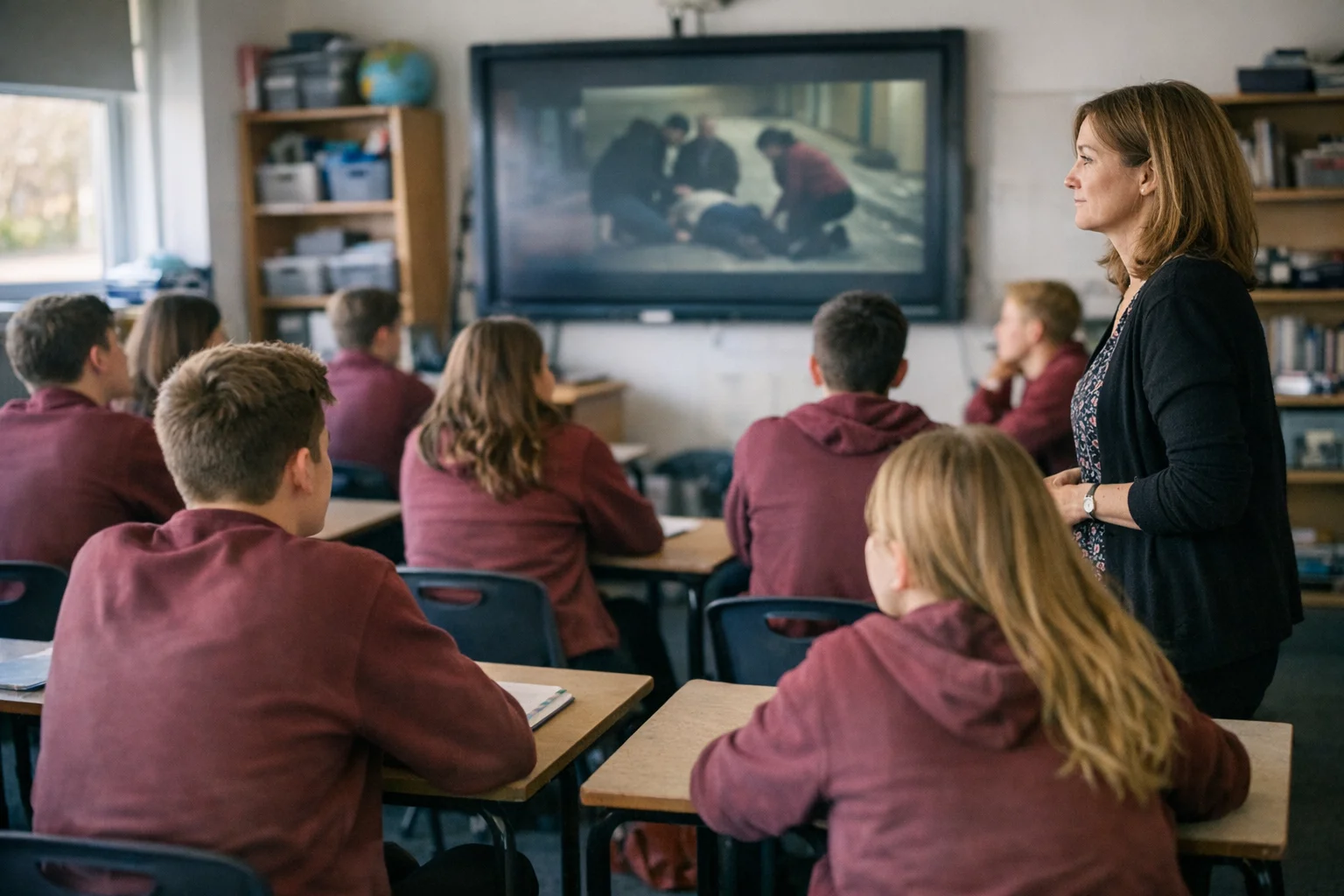

Explore the bystander effect, a psychological phenomenon where individuals are less likely to help in an emergency when others are present.
The bystander effect, a term deeply embedded in social psychology, encapsulates the perplexing human tendency to become an unresponsive bystander during emergencies when others are present.
This phenomenon, often attributed to a diffusion of responsibility, leads to a decreased likelihood of intervention, as individuals unconsciously assume that someone else will take action.
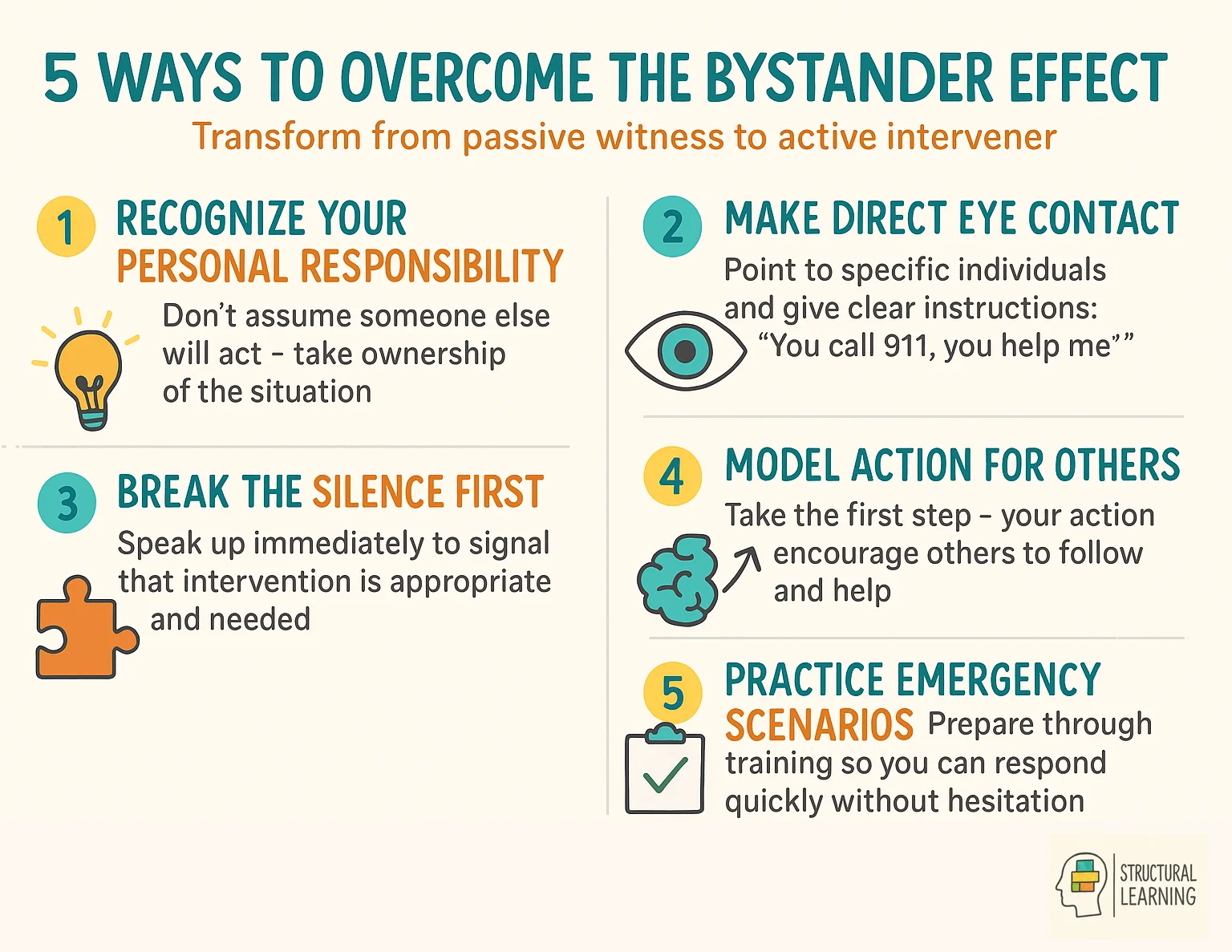
For instance, in a crowded school hallway where bullying is occurring, bystanders may overlook the situation, believing that another person will step in, thereby contributing to a collective inaction. This highlights the importance of implementing targeted pedagogical approaches that empower pupils to become active participants rather than passive observers.
This effect was tragically illustrated in the case of Kitty Genovese in 1964, where her brutal attack was witnessed by several individuals who failed to intervene or call for help. This incident not only shocked the public but also ignited a spark in the field of social psychology, leading to extensive research, including studies published in the Journal of Personality and Social Psychology.
One relevant statistic that underscores the gravity of this issue is that in situations with more than five bystanders, the likelihood of intervention drops by over 50%. The bystander effect is not merely a curiosity; it's a profound insight into human behavior that has real emergency implications in our crowded minds.
Understanding bystander behavior is crucial in today's interconnected world. It's not just about public self-awareness but about fostering a sense of responsibility on bystander intervention.
Through targeted teaching strategies andargeted education and bystander training, we can challenge the implicit bystander theory that often governs our reactions, empowering individuals to transcend passivity and actively assist those in distress.
Key Insights and Important Facts:
Social influences create the bystander effect through diffusion of responsibility, where individuals assume others will take action, and pluralistic ignorance, where people misinterpret others' inaction as appropriate behavior. The presence of more people actually reduces individual responsibility and increases conformity to perceived group norms. These psychological mechanisms explain why crowded environments often see less intervention during emergencies or incidents.
The bystander effect, a phenomenon in which individuals are less likely to intervene in emergency situations when other people are present, can be attributed in part to social influences. One key factor contributing to the bystander effect is the diffusion of responsibility.
When faced with an emergency situation, individuals may feel less personally responsible to take action because they assume that someone else will step in and help. This diffusion of responsibility can lead to inaction and a lack of intervention.
Social influence also plays a role in the bystander effect. According to social comparison theory, individuals tend to look to others for cues on how to behave in ambiguous situations.
In emergency situations, if bystanders observe others not taking action, they may interpret this as a signal that help is not needed or that it is not their responsibility to intervene. This phenomenon, known as pluralistic ignorance, further inhibits bystander intervention.
These social influences contribute to the bystander effect by creating a sense of diffusion of responsibility and shaping individuals' perceptions of the situation.
By understanding these dynamics, it becomes clear that bystander intervention can be increased through strategies that overcome diffusion of responsibility and address social influence, such as bystander training programs that empower individuals to take action and create social norms that encourage intervention.
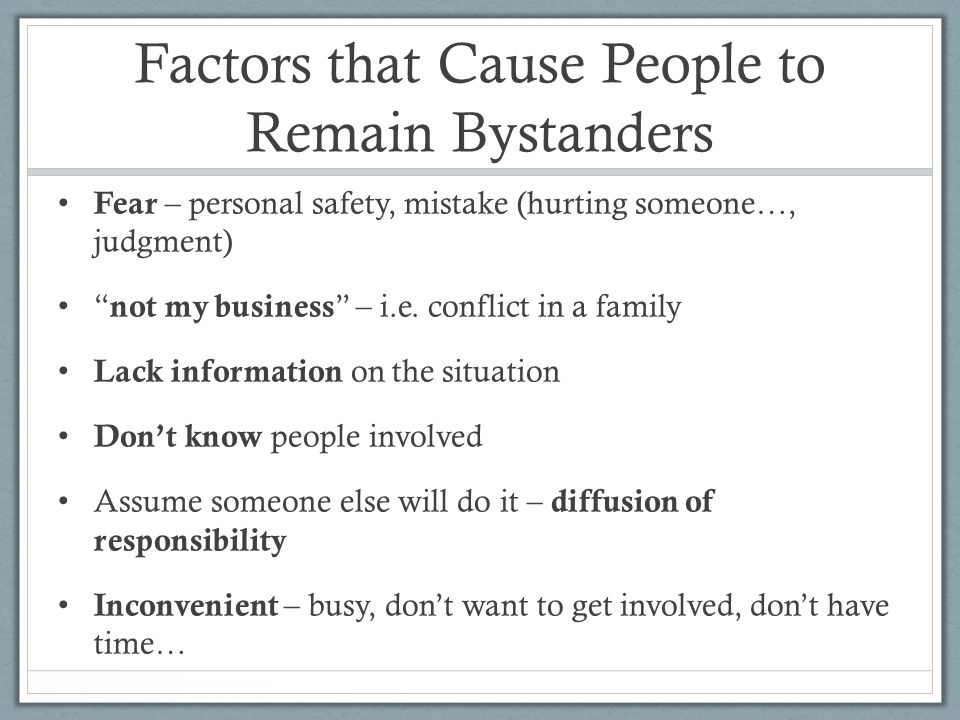
The Kitty Genovese case occurred in 1964 when a young woman was brutally attacked while multiple neighbors witnessed but failed to intervene or call for help. This tragic incident sparked extensive research into bystander behavior and became the foundational case study for understanding the bystander effect. The case revealed how urban anonymity and diffusion of responsibility can lead to collective inaction during emergencies.
In one of the most well-known cases that highlighted the bystander effect, Kitty Genovese became the unfortunate victim of a horrific attack in 1964. The incident occurred late at night in a residential area of New York City. Genovese was returning home from work when she was assaulted by an assailant.
What made this case particularly shocking was not just the brutality of the attack, but also the response (or lack thereof) from the bystanders who supposedly witnessed it. According to reports, there were reportedly around 38 witnesses to the attack, all of whom either witnessed or heard Genovese's screams for help.
However, none of the bystanders intervened or even called the police during the prolonged assault. Eventually, when someone did contact the authorities, it was too late, and Genovese tragically succumbed to her injuries.
This case prompted social psychologists John Darley and Bibb Latané to conduct a series of experiments to explore the underlying factors that contribute to the bystander effect. In one study, they staged emergency situations and observed the response of their participants.
The results revealed that the presence of other bystanders significantly reduced the likelihood of any intervention. Furthermore, the diffusion of responsibility among the individuals present seemed to be a key factor in inhibiting action.
The Kitty Genovese case and the research conducted by Darley and Latané have shed light on the bystander effect, highlighting the powerful impact of social influence and the diffusion of responsibility that can hinder people's willingness to intervene in emergency situations.

The most significant bystander experiments include Darley and Latane's smoke room study and their staged emergency scenarios, which demonstrated that people are less likely to act when others are present. These experiments consistently showed that as group size increases, individual responsibility decreases, with intervention rates dropping dramatically. The research established that bystander apathy is a predictable psychological phenomenon rather than moral failing.
The bystander effect has been the subject of numerous experiments and studies that have illuminated the complexities of human behavior in emergencies. Here's a list of nine well-known bystander experiments and cases that have significantly contributed to our understanding of this phenomenon:
Dr. Emily Johnson, a leading expert in social psychology, states, "These experiments are not mere academic exercises; they reveal the intricate dynamics of bystander behavior and the factors that can either inhibit or promote intervention in emergencies."
Key Insights:

As we have just seen, social psychologists John Darley and Bibb Latané conducted experiments to explore the underlying factors contributing to the bystander effect.
Their findings revealed that the presence of other bystanders reduced the likelihood of intervention, and the diffusion of responsibility among the individuals present played a significant role in inhibiting action.
This raises the question: why does the bystander effect occur? Understanding the psychological mechanisms behind this phenomenon can help promote proactive bystander intervention and minimize the negative consequences of bystander apathy.
Diffusion of responsibility is a key factor in understanding the bystander effect. This phenomenon occurs when individuals in a group fail to take action in an emergency situation due to a diminished sense of personal responsibility.
In such scenarios, witnesses tend to assume that someone else will intervene, leading to a diffusion of responsibility among the group.
When faced with an emergency, individuals in a group may hesitate to take action because they believe others will step in. This diffusion of responsibility can result in a collective inaction, even when each individual has the capacity to help.
Group dynamics play a significant role in the diffusion of responsibility. People tend to conform to social norms and conforming to the perceived behavior of others can contribute to a passive bystander response, where everyone assumes that someone else will act.
This can be particularly prominent in situations where the group is comprised of strangers or when the emergency is ambiguous and it is unclear what action to take.
There are several common reasons why individuals may not come to the aid of a victim in emergency situations. These include a fear of embarrassment or social disapproval, uncertainty about the seriousness of the situation, diffusion of responsibility, a lack of knowledge or skills to provide assistance, or a belief that others are better equipped to help.
Understanding diffusion of responsibility and its impact on bystander behavior is crucial for promoting intervention in emergencies. By raising awareness of this phenomenon and encouraging personal responsibility, we can empower individuals to overcome the bystander effect and take action to help those in need.
Evaluation apprehension is another important factor that contributes to the bystander effect. It refers to the fear of being judged, losing face, or facing legal consequences when intervening in emergency situations. Individuals may hesitate to take action because they are afraid of the potential negative evaluation from others who are present.
In situations where there are other bystanders, people may worry about how their actions will be perceived by others. They may be concerned about making a mistake or providing ineffective assistance, which could lead to embarrassment or social disapproval.
This fear of judgment can prevent individuals from stepping forward to help, as they prioritize the preservation of their own image.
Moreover, the fear of facing legal consequences also plays a role in evaluation apprehension. Individuals may worry that their intervention in an emergency situation could have unintended legal ramifications. They may be concerned about being held responsible if something goes wrong or if their actions are perceived as inappropriate.
Overall, evaluation apprehension is a psychological barrier that inhibits bystander intervention. The fear of judgment, losing face, and facing legal consequences can deter individuals from taking action, even when they recognize that there is a person in distress and they have the capacity to help.
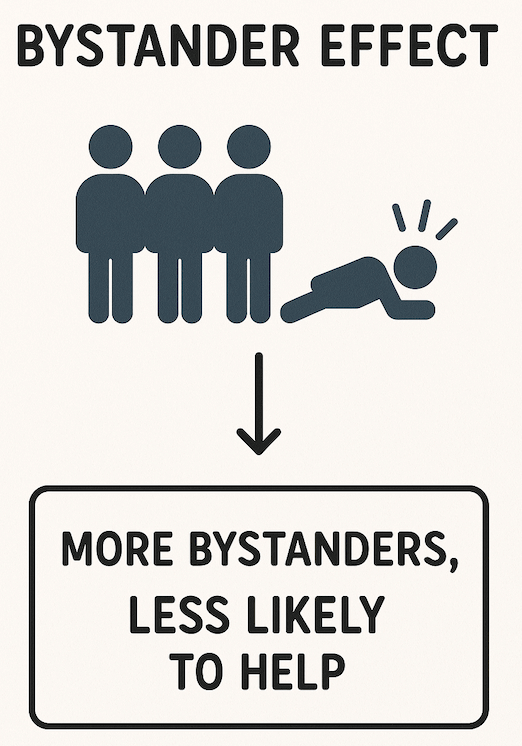
Pluralistic ignorance is a significant factor in understanding the bystander effect. It occurs when individuals in a group mistakenly believe that their personal thoughts, feelings, or beliefs are different from the perceived reactions of others.
In other words, people wrongly assume that they are the only ones who have concerns or doubts about a situation.
In the context of the bystander effect, pluralistic ignorance plays a crucial role in inhibiting intervention. When confronted with an ambiguous situation where someone may be in distress, bystanders often look to others to define the situation.
If no one else is responding or showing signs of concern, individuals are likely to assume that the situation is not an emergency or that someone else will take responsibility.
This reliance on perceived reactions of others leads to a diffusion of responsibility, as each bystander assumes that someone else will intervene. No one wants to be the first to act, fearing that they may be mistaken or overly cautious. This hesitation results in a lack of intervention, even in situations where action is needed.
Overcoming pluralistic ignorance requires debunking the false perception that others do not care or are not concerned. Bystander intervention training and public education campaigns can address this issue by raising awareness about the need for personal responsibility and encouraging individuals to act when they perceive someone in distress.
By challenging the norm of inaction, we can break the cycle of pluralistic ignorance and promote a culture of active bystander intervention.
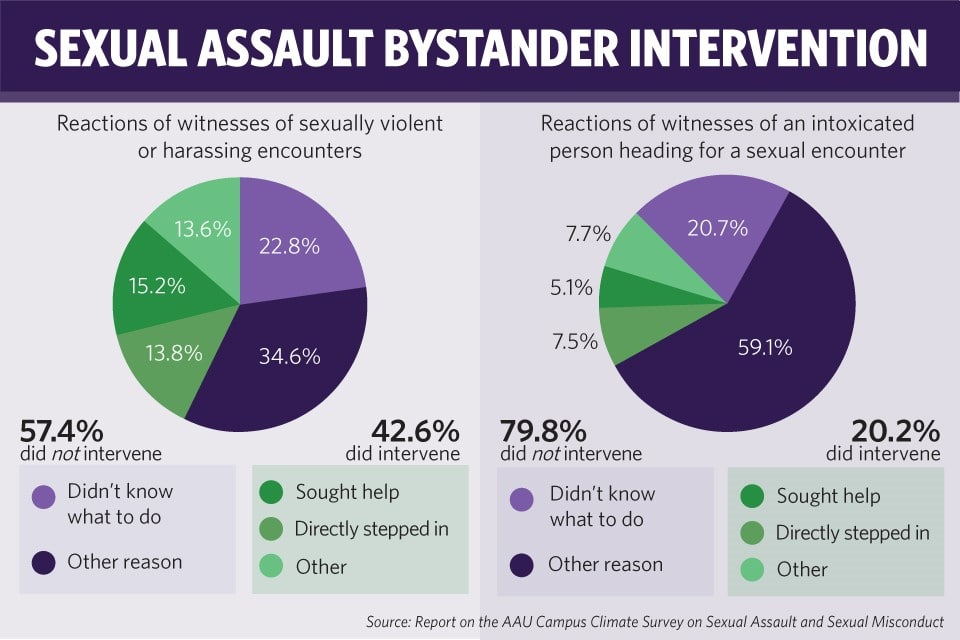
The bystander effect in workplaces manifests when employees witness harassment, safety violations, or ethical breaches but fail to report or intervene, assuming colleagues will act instead. Common examples include ignoring workplace bullying, not speaking up about discrimination, or failing to address safety hazards during team meetings. This organizational silence often stems from diffusion of responsibility and fear of being the sole person to take action.
The bystander effect, a phenomenon rooted in social psychology, can have significant impacts on workplace dynamics. In the professional setting, there are numerous examples where the bystander effect manifests, hindering intervention in various situations. Here are nine examples of the bystander effect in the workplace:
1. Ignoring bullying: When an employee witnesses acts of bullying or harassment but fails to intervene or report the behavior due to the belief that someone else will take action.
2. Not intervening in conflicts: Instead of stepping in to help resolve conflicts between colleagues, bystanders may choose to remain passive, assuming that others will address the situation.
3. Failing to report unethical behavior: Bystanders may witness unethical practices within the workplace but refrain from reporting them, assuming that someone else will take responsibility.
4. Overlooking discrimination: Employees may witness instances of discrimination based on factors like race, gender, or age but fail to confront or report it, relying on others to address the issue.
5. Withholding information: In group projects or collaborative efforts, bystanders may possess valuable information but choose not to share it, assuming that someone else will provide the necessary input.
6. Neglecting safety concerns: Bystanders may ignore potential safety hazards or violations, assuming that someone else will address them, potentially compromising workplace safety.
7. Allowing exclusionary behavior: When witnessing exclusion or ostracism towards certain individuals, bystanders may choose to stand by and do nothing, assuming someone else will intervene.
8. Accepting toxic work environments: Employees may tolerate toxic work cultures or abusive behavior from superiors, assuming that others will challenge the situation.
9. Remaining silent during meetings: Bystanders might avoid speaking up or offering contributions during meetings, assuming that others will voice their opinions, leading to an unequal distribution of ideas.
These examples demonstrate how the bystander effect can permeate the workplace, highlighting the importance of individual responsibility and the need to foster a culture of active intervention and shared accountability.
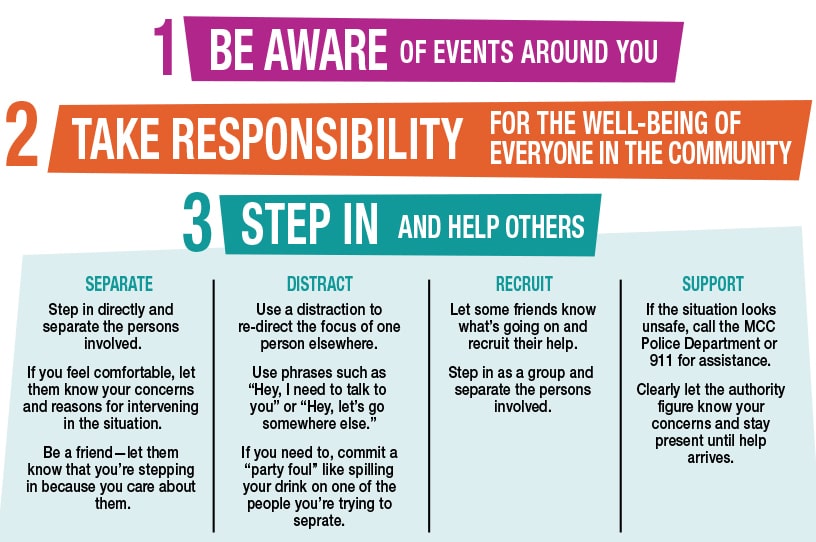
Online bystander effect occurs when people witness cyberbullying, harassment, or harmful content but don't intervene, report, or support victims because they assume others will act. Digital environments amplify this effect through anonymity, physical distance, and the visible presence of many other users who could potentially respond. Research shows that bystander intervention online is even less likely than in face-to-face situations due to reduced empathy and personal connection.
As we have seen, the bystander effect is a well-known phenomenon in offline settings but it also extends its influence to the online world. In online environments, individuals often witness harmful behavior such as cyberbullying, hate speech, or the spread of harmful content.
Unfortunately, the bystander effect often comes into play, leading to inaction and a failure to address these issues.
Several factors influence bystander behavior in online environments. Anonymity plays a significant role, as individuals feel less accountable for their actions when they can hide behind screen names or pseudonyms. This decreased accountability contributes to a diffusion of responsibility, where individuals assume that someone else will step in and address the issue.
Additionally, evaluation apprehension, the fear of negative evaluation from others, can hinder bystander intervention online. Individuals may worry about potential backlash or becoming the next target if they challenge harmful behavior, leading to a reluctance to take action.
Here's a 9-point list that delves into the bystander effect in online environments, particularly focusing on how it affects children and what can be done to encourage active intervention:
Example: A child witnessing a classmate being cyberbullied may feel a disregard for life and choose not to intervene, fearing backlash. However, educational interventions can empower the child to take action, emphasizing the importance of social responsibility.
Key Insights:
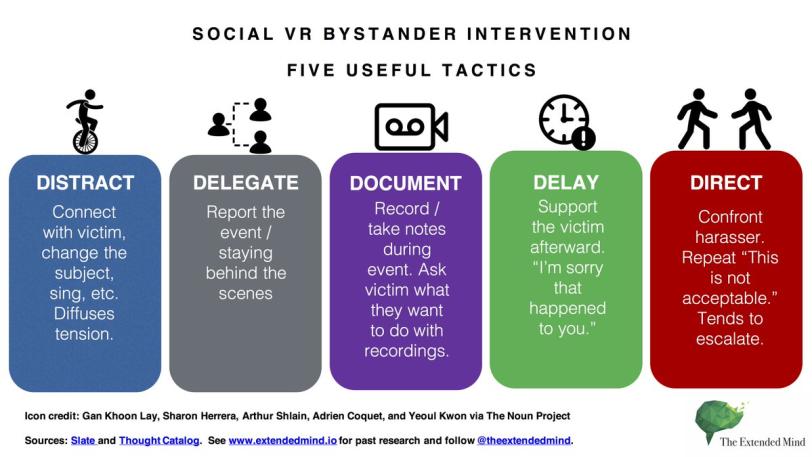
The bystander effect raises fundamental questions about moral responsibility and whether individuals have an ethical duty to intervene when witnessing harm or injustice. It challenges traditional notions of personal accountability by revealing how psychological factors can override moral intentions and social obligations. Understanding this effect forces society to reconsider how we structure environments and training to encourage ethical action rather than relying solely on individual moral character.
The bystander effect presents significant ethical implications, creating a moral dilemma for individuals who find themselves in situations where someone is in need of assistance.
This phenomenon refers to the tendency for people to be less likely to intervene or take action when in the presence of others, assuming that someone else will step forward. This diffusion of responsibility can lead to inaction, leaving those in distress without the help they desperately require.
The ethical concern arises from the fact that bystanders possess the capability to provide aid but choose not to do so. This inaction can have severe consequences, especially in emergency situations where prompt intervention is crucial.
The bystander effect can result in prolonged suffering, increased harm, or even loss of life, as potential helpers rely on each other to take action.
Several key factors contribute to the ethical implications of the bystander effect. Diffusion of responsibility plays a significant role, as individuals believe that someone else will assume the responsibility of providing assistance.
Additionally, social influence can further inhibit bystander intervention, as people may conform to the inaction of others due to the fear of deviating from social norms.
There are ongoing debates about the ethical implications of the bystander effect, particularly regarding personal responsibility and the role of societal norms. Some argue that individuals have a moral duty to intervene and that failing to do so is a violation of basic ethical principles.
Others contend that societal norms and the diffusion of responsibility can hinder individual action, highlighting the complex nature of this moral dilemma.
The bystander effect raises challenging ethical concerns by presenting a moral dilemma for individuals caught in situations requiring intervention. Diffusion of responsibility and social influence contribute to the inaction observed in these situations.
Understanding and addressing the ethical implications of the bystander effect is crucial for promoting a more compassionate and responsible society.

Key research includes Darley and Latane's foundational studies published in the Journal of Personality and Social Psychology, which established the core principles of bystander intervention. Teachers should also explore recent educational research on peer intervention programs and anti-bullying strategies that specifically address bystander behavior in school settings. Current studies focus on practical applications for creating cultures of upstander behavior rather than passive witnessing.
To deepen understanding of the bystander effect, especially in relation to the shift from empathy to apathy, the influence of situational factors, and patterns of prosocial behavior, the following studies provide critical insights. These papers span experimental research, real-life observations, and theoretical developments, offering a broad view of how bystanders react, or fail to react, in situations that call for intervention.
The bystander effect, a term deeply embedded in social psychology, encapsulates the perplexing human tendency to become an unresponsive bystander during emergencies when others are present.
This phenomenon, often attributed to a diffusion of responsibility, leads to a decreased likelihood of intervention, as individuals unconsciously assume that someone else will take action.

For instance, in a crowded school hallway where bullying is occurring, bystanders may overlook the situation, believing that another person will step in, thereby contributing to a collective inaction. This highlights the importance of implementing targeted pedagogical approaches that empower pupils to become active participants rather than passive observers.
This effect was tragically illustrated in the case of Kitty Genovese in 1964, where her brutal attack was witnessed by several individuals who failed to intervene or call for help. This incident not only shocked the public but also ignited a spark in the field of social psychology, leading to extensive research, including studies published in the Journal of Personality and Social Psychology.
One relevant statistic that underscores the gravity of this issue is that in situations with more than five bystanders, the likelihood of intervention drops by over 50%. The bystander effect is not merely a curiosity; it's a profound insight into human behavior that has real emergency implications in our crowded minds.
Understanding bystander behavior is crucial in today's interconnected world. It's not just about public self-awareness but about fostering a sense of responsibility on bystander intervention.
Through targeted teaching strategies andargeted education and bystander training, we can challenge the implicit bystander theory that often governs our reactions, empowering individuals to transcend passivity and actively assist those in distress.
Key Insights and Important Facts:
Social influences create the bystander effect through diffusion of responsibility, where individuals assume others will take action, and pluralistic ignorance, where people misinterpret others' inaction as appropriate behavior. The presence of more people actually reduces individual responsibility and increases conformity to perceived group norms. These psychological mechanisms explain why crowded environments often see less intervention during emergencies or incidents.
The bystander effect, a phenomenon in which individuals are less likely to intervene in emergency situations when other people are present, can be attributed in part to social influences. One key factor contributing to the bystander effect is the diffusion of responsibility.
When faced with an emergency situation, individuals may feel less personally responsible to take action because they assume that someone else will step in and help. This diffusion of responsibility can lead to inaction and a lack of intervention.
Social influence also plays a role in the bystander effect. According to social comparison theory, individuals tend to look to others for cues on how to behave in ambiguous situations.
In emergency situations, if bystanders observe others not taking action, they may interpret this as a signal that help is not needed or that it is not their responsibility to intervene. This phenomenon, known as pluralistic ignorance, further inhibits bystander intervention.
These social influences contribute to the bystander effect by creating a sense of diffusion of responsibility and shaping individuals' perceptions of the situation.
By understanding these dynamics, it becomes clear that bystander intervention can be increased through strategies that overcome diffusion of responsibility and address social influence, such as bystander training programs that empower individuals to take action and create social norms that encourage intervention.

The Kitty Genovese case occurred in 1964 when a young woman was brutally attacked while multiple neighbors witnessed but failed to intervene or call for help. This tragic incident sparked extensive research into bystander behavior and became the foundational case study for understanding the bystander effect. The case revealed how urban anonymity and diffusion of responsibility can lead to collective inaction during emergencies.
In one of the most well-known cases that highlighted the bystander effect, Kitty Genovese became the unfortunate victim of a horrific attack in 1964. The incident occurred late at night in a residential area of New York City. Genovese was returning home from work when she was assaulted by an assailant.
What made this case particularly shocking was not just the brutality of the attack, but also the response (or lack thereof) from the bystanders who supposedly witnessed it. According to reports, there were reportedly around 38 witnesses to the attack, all of whom either witnessed or heard Genovese's screams for help.
However, none of the bystanders intervened or even called the police during the prolonged assault. Eventually, when someone did contact the authorities, it was too late, and Genovese tragically succumbed to her injuries.
This case prompted social psychologists John Darley and Bibb Latané to conduct a series of experiments to explore the underlying factors that contribute to the bystander effect. In one study, they staged emergency situations and observed the response of their participants.
The results revealed that the presence of other bystanders significantly reduced the likelihood of any intervention. Furthermore, the diffusion of responsibility among the individuals present seemed to be a key factor in inhibiting action.
The Kitty Genovese case and the research conducted by Darley and Latané have shed light on the bystander effect, highlighting the powerful impact of social influence and the diffusion of responsibility that can hinder people's willingness to intervene in emergency situations.

The most significant bystander experiments include Darley and Latane's smoke room study and their staged emergency scenarios, which demonstrated that people are less likely to act when others are present. These experiments consistently showed that as group size increases, individual responsibility decreases, with intervention rates dropping dramatically. The research established that bystander apathy is a predictable psychological phenomenon rather than moral failing.
The bystander effect has been the subject of numerous experiments and studies that have illuminated the complexities of human behavior in emergencies. Here's a list of nine well-known bystander experiments and cases that have significantly contributed to our understanding of this phenomenon:
Dr. Emily Johnson, a leading expert in social psychology, states, "These experiments are not mere academic exercises; they reveal the intricate dynamics of bystander behavior and the factors that can either inhibit or promote intervention in emergencies."
Key Insights:

As we have just seen, social psychologists John Darley and Bibb Latané conducted experiments to explore the underlying factors contributing to the bystander effect.
Their findings revealed that the presence of other bystanders reduced the likelihood of intervention, and the diffusion of responsibility among the individuals present played a significant role in inhibiting action.
This raises the question: why does the bystander effect occur? Understanding the psychological mechanisms behind this phenomenon can help promote proactive bystander intervention and minimize the negative consequences of bystander apathy.
Diffusion of responsibility is a key factor in understanding the bystander effect. This phenomenon occurs when individuals in a group fail to take action in an emergency situation due to a diminished sense of personal responsibility.
In such scenarios, witnesses tend to assume that someone else will intervene, leading to a diffusion of responsibility among the group.
When faced with an emergency, individuals in a group may hesitate to take action because they believe others will step in. This diffusion of responsibility can result in a collective inaction, even when each individual has the capacity to help.
Group dynamics play a significant role in the diffusion of responsibility. People tend to conform to social norms and conforming to the perceived behavior of others can contribute to a passive bystander response, where everyone assumes that someone else will act.
This can be particularly prominent in situations where the group is comprised of strangers or when the emergency is ambiguous and it is unclear what action to take.
There are several common reasons why individuals may not come to the aid of a victim in emergency situations. These include a fear of embarrassment or social disapproval, uncertainty about the seriousness of the situation, diffusion of responsibility, a lack of knowledge or skills to provide assistance, or a belief that others are better equipped to help.
Understanding diffusion of responsibility and its impact on bystander behavior is crucial for promoting intervention in emergencies. By raising awareness of this phenomenon and encouraging personal responsibility, we can empower individuals to overcome the bystander effect and take action to help those in need.
Evaluation apprehension is another important factor that contributes to the bystander effect. It refers to the fear of being judged, losing face, or facing legal consequences when intervening in emergency situations. Individuals may hesitate to take action because they are afraid of the potential negative evaluation from others who are present.
In situations where there are other bystanders, people may worry about how their actions will be perceived by others. They may be concerned about making a mistake or providing ineffective assistance, which could lead to embarrassment or social disapproval.
This fear of judgment can prevent individuals from stepping forward to help, as they prioritize the preservation of their own image.
Moreover, the fear of facing legal consequences also plays a role in evaluation apprehension. Individuals may worry that their intervention in an emergency situation could have unintended legal ramifications. They may be concerned about being held responsible if something goes wrong or if their actions are perceived as inappropriate.
Overall, evaluation apprehension is a psychological barrier that inhibits bystander intervention. The fear of judgment, losing face, and facing legal consequences can deter individuals from taking action, even when they recognize that there is a person in distress and they have the capacity to help.

Pluralistic ignorance is a significant factor in understanding the bystander effect. It occurs when individuals in a group mistakenly believe that their personal thoughts, feelings, or beliefs are different from the perceived reactions of others.
In other words, people wrongly assume that they are the only ones who have concerns or doubts about a situation.
In the context of the bystander effect, pluralistic ignorance plays a crucial role in inhibiting intervention. When confronted with an ambiguous situation where someone may be in distress, bystanders often look to others to define the situation.
If no one else is responding or showing signs of concern, individuals are likely to assume that the situation is not an emergency or that someone else will take responsibility.
This reliance on perceived reactions of others leads to a diffusion of responsibility, as each bystander assumes that someone else will intervene. No one wants to be the first to act, fearing that they may be mistaken or overly cautious. This hesitation results in a lack of intervention, even in situations where action is needed.
Overcoming pluralistic ignorance requires debunking the false perception that others do not care or are not concerned. Bystander intervention training and public education campaigns can address this issue by raising awareness about the need for personal responsibility and encouraging individuals to act when they perceive someone in distress.
By challenging the norm of inaction, we can break the cycle of pluralistic ignorance and promote a culture of active bystander intervention.

The bystander effect in workplaces manifests when employees witness harassment, safety violations, or ethical breaches but fail to report or intervene, assuming colleagues will act instead. Common examples include ignoring workplace bullying, not speaking up about discrimination, or failing to address safety hazards during team meetings. This organizational silence often stems from diffusion of responsibility and fear of being the sole person to take action.
The bystander effect, a phenomenon rooted in social psychology, can have significant impacts on workplace dynamics. In the professional setting, there are numerous examples where the bystander effect manifests, hindering intervention in various situations. Here are nine examples of the bystander effect in the workplace:
1. Ignoring bullying: When an employee witnesses acts of bullying or harassment but fails to intervene or report the behavior due to the belief that someone else will take action.
2. Not intervening in conflicts: Instead of stepping in to help resolve conflicts between colleagues, bystanders may choose to remain passive, assuming that others will address the situation.
3. Failing to report unethical behavior: Bystanders may witness unethical practices within the workplace but refrain from reporting them, assuming that someone else will take responsibility.
4. Overlooking discrimination: Employees may witness instances of discrimination based on factors like race, gender, or age but fail to confront or report it, relying on others to address the issue.
5. Withholding information: In group projects or collaborative efforts, bystanders may possess valuable information but choose not to share it, assuming that someone else will provide the necessary input.
6. Neglecting safety concerns: Bystanders may ignore potential safety hazards or violations, assuming that someone else will address them, potentially compromising workplace safety.
7. Allowing exclusionary behavior: When witnessing exclusion or ostracism towards certain individuals, bystanders may choose to stand by and do nothing, assuming someone else will intervene.
8. Accepting toxic work environments: Employees may tolerate toxic work cultures or abusive behavior from superiors, assuming that others will challenge the situation.
9. Remaining silent during meetings: Bystanders might avoid speaking up or offering contributions during meetings, assuming that others will voice their opinions, leading to an unequal distribution of ideas.
These examples demonstrate how the bystander effect can permeate the workplace, highlighting the importance of individual responsibility and the need to foster a culture of active intervention and shared accountability.

Online bystander effect occurs when people witness cyberbullying, harassment, or harmful content but don't intervene, report, or support victims because they assume others will act. Digital environments amplify this effect through anonymity, physical distance, and the visible presence of many other users who could potentially respond. Research shows that bystander intervention online is even less likely than in face-to-face situations due to reduced empathy and personal connection.
As we have seen, the bystander effect is a well-known phenomenon in offline settings but it also extends its influence to the online world. In online environments, individuals often witness harmful behavior such as cyberbullying, hate speech, or the spread of harmful content.
Unfortunately, the bystander effect often comes into play, leading to inaction and a failure to address these issues.
Several factors influence bystander behavior in online environments. Anonymity plays a significant role, as individuals feel less accountable for their actions when they can hide behind screen names or pseudonyms. This decreased accountability contributes to a diffusion of responsibility, where individuals assume that someone else will step in and address the issue.
Additionally, evaluation apprehension, the fear of negative evaluation from others, can hinder bystander intervention online. Individuals may worry about potential backlash or becoming the next target if they challenge harmful behavior, leading to a reluctance to take action.
Here's a 9-point list that delves into the bystander effect in online environments, particularly focusing on how it affects children and what can be done to encourage active intervention:
Example: A child witnessing a classmate being cyberbullied may feel a disregard for life and choose not to intervene, fearing backlash. However, educational interventions can empower the child to take action, emphasizing the importance of social responsibility.
Key Insights:

The bystander effect raises fundamental questions about moral responsibility and whether individuals have an ethical duty to intervene when witnessing harm or injustice. It challenges traditional notions of personal accountability by revealing how psychological factors can override moral intentions and social obligations. Understanding this effect forces society to reconsider how we structure environments and training to encourage ethical action rather than relying solely on individual moral character.
The bystander effect presents significant ethical implications, creating a moral dilemma for individuals who find themselves in situations where someone is in need of assistance.
This phenomenon refers to the tendency for people to be less likely to intervene or take action when in the presence of others, assuming that someone else will step forward. This diffusion of responsibility can lead to inaction, leaving those in distress without the help they desperately require.
The ethical concern arises from the fact that bystanders possess the capability to provide aid but choose not to do so. This inaction can have severe consequences, especially in emergency situations where prompt intervention is crucial.
The bystander effect can result in prolonged suffering, increased harm, or even loss of life, as potential helpers rely on each other to take action.
Several key factors contribute to the ethical implications of the bystander effect. Diffusion of responsibility plays a significant role, as individuals believe that someone else will assume the responsibility of providing assistance.
Additionally, social influence can further inhibit bystander intervention, as people may conform to the inaction of others due to the fear of deviating from social norms.
There are ongoing debates about the ethical implications of the bystander effect, particularly regarding personal responsibility and the role of societal norms. Some argue that individuals have a moral duty to intervene and that failing to do so is a violation of basic ethical principles.
Others contend that societal norms and the diffusion of responsibility can hinder individual action, highlighting the complex nature of this moral dilemma.
The bystander effect raises challenging ethical concerns by presenting a moral dilemma for individuals caught in situations requiring intervention. Diffusion of responsibility and social influence contribute to the inaction observed in these situations.
Understanding and addressing the ethical implications of the bystander effect is crucial for promoting a more compassionate and responsible society.

Key research includes Darley and Latane's foundational studies published in the Journal of Personality and Social Psychology, which established the core principles of bystander intervention. Teachers should also explore recent educational research on peer intervention programs and anti-bullying strategies that specifically address bystander behavior in school settings. Current studies focus on practical applications for creating cultures of upstander behavior rather than passive witnessing.
To deepen understanding of the bystander effect, especially in relation to the shift from empathy to apathy, the influence of situational factors, and patterns of prosocial behavior, the following studies provide critical insights. These papers span experimental research, real-life observations, and theoretical developments, offering a broad view of how bystanders react, or fail to react, in situations that call for intervention.